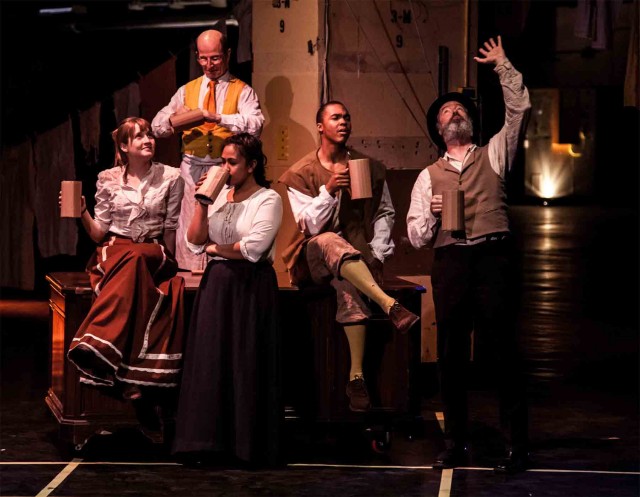
Charles Pfaff (Everett Quinton, at back) serves thirsty drinkers mugs of beer at the Vault in MANNA-HATTA (photo by Dan Lane Williams)
The James A. Farley Post Office
425 Eighth Ave. at 31st St.
Thursday – Sunday through June 23, $18, 7:00
www.peculiarworks.org
Now in its twentieth year, Obie-winning theater company Peculiar Works Project has taken on quite a task for its latest immersive, site-specific show, telling the long, complex history of New York City in Manna-Hatta. Written by Barry Rowell and directed by Rowell and Kathleen Amshoff, Manna-Hatta features twenty actors playing more than one hundred roles as the production moves through a series of rooms and hallways on the third and fourth floors of the historic James A. Farley Post Office. The audience is divided into four sections, led by either presidential candidate Shirley Chisholm (Cherrye J. Davis), poet Walt Whitman (Christopher Hurt), author-activist Jane Jacobs (Catherine Porter), or Lenape chief Easanques (Tina Chilip). Examining power and corruption, immigration and corruption, city planning and corruption, business and corruption, and culture and discrimination, the show’s goal is stated at the very beginning when one of four men simultaneously playing W. Parker Chase announces, “We love New York and want everybody, everywhere, to know what a truly wonder city New York really is.” The four Parker Chases appear as a quartet throughout the show, including a terrific turn as the “Four Peters (Well, Three and a Half),” as they perform a song-and-dance number about Peter Stuyvesant, Peter Minuit, Peter Schagen, and Peter Cooper; Eric C. Bailey also plays Boss Tweed, Bradley Wells plays Robert Moses, J. Kelly Salvadore plays Jimmy Walker, and Everett Quinton plays Charles Ignatious Pfaff, among other characters. Quinton, the former artistic director of Charles Ludlam’s Ridiculous Theatrical Company, is particularly effective, radiating an infectious humor and energy that helps drive the show even during its slow patches, of which there are too many. Clocking in at about three hours and fifteen minutes (with a free-beer-and-pretzels intermission), Manna-Hatta is very long, especially since the audience is standing most of the time, although it’s fascinating to wander through the abandoned spaces, where plaques still identify employees and their positions, as if the workers all disappeared one night, leaving behind a kind of ghost town. Rowell and Amshoff try to squeeze in too much of New York’s history, and it gets confusing why they emphasize certain moments while giving short shrift to others, but it’s a still a rousing triumph, a lighthearted and fun if exhausting trip through Gotham, with some of the highlights being the unique way the troupe portrays the development of Manhattan’s street grid, the building of the Brooklyn Bridge, and the Triangle Shirtwaist factory fire. Manna-Hatta continues Thursday–Sunday through June 23, with tickets only $18, but be prepared to do a lot of standing, walking, and stair climbing.